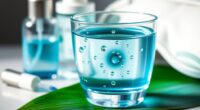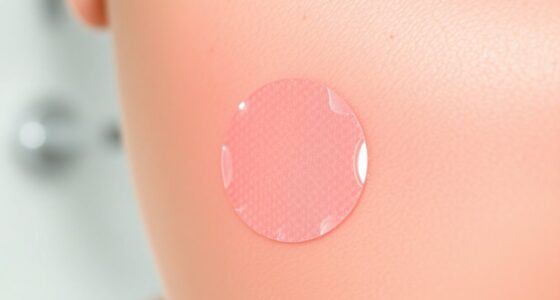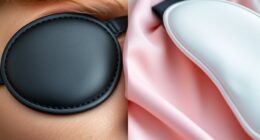Pimple patches work best for recent whiteheads and mild papules but struggle with deeper breakouts like cystic or nodular acne. They won’t penetrate inflamed pimples without visible whiteheads or treat blackheads due to lack of fluid. Applying patches incorrectly or on dirty skin can also limit their effectiveness. If you’re dealing with stubborn acne, consider exploring alternative treatments or enhancing your skincare routine. Keep going to discover more about managing your acne effectively!
Key Takeaways
- Pimple patches are ineffective for cystic acne or nodular pimples, as they don’t penetrate deep enough to target these types.
- Inflamed pimples without visible whiteheads may not respond well to patches, limiting their effectiveness on certain acne forms.
- Patches are unsuitable for blackheads or clogged pores since they require fluid for absorption, which is absent in these cases.
- Sensitive skin may react negatively to patches, leading to irritation or allergic reactions, especially with prolonged use.
- For severe or persistent acne, consult a dermatologist for alternative treatments like retinoids, oral medications, or professional therapies.
Understanding the Types of Pimples: Which Ones Can Patches Help?

When you’re dealing with breakouts, it’s essential to know which types of pimple patches can help. Pimple patches, especially hydrocolloid patches, work wonders on whiteheads and recent papules. They absorb excess oil and promote healing for mild to moderate acne.
However, if you’re facing cystic acne or nodular pimples, these patches mightn’t be effective, as they target lesions deeper beneath the skin. For ideal results, apply a pimple patch to clean, dry skin after cleansing and toning; this maximizes their adhesion and efficacy.
Common Mistakes When Using Pimple Patches

Many people make common mistakes when using pimple patches that can compromise their effectiveness. One major error is applying patches on dirty or oily skin; always cleanse and dry the area first for better adhesion.
Another mistake is using patches at the wrong step in your skincare routine. Applying them after other products can cause them to fall off or not stick properly. Additionally, remember that pimple patches aren’t a miracle cure for cystic acne, which often requires different acne treatment.
Leaving a patch on for too short or too long limits its effectiveness—aim for 6 to 24 hours. Finally, using the wrong size can diminish results, so choose patches that adequately cover your breakouts.
The Importance of Proper Application Techniques
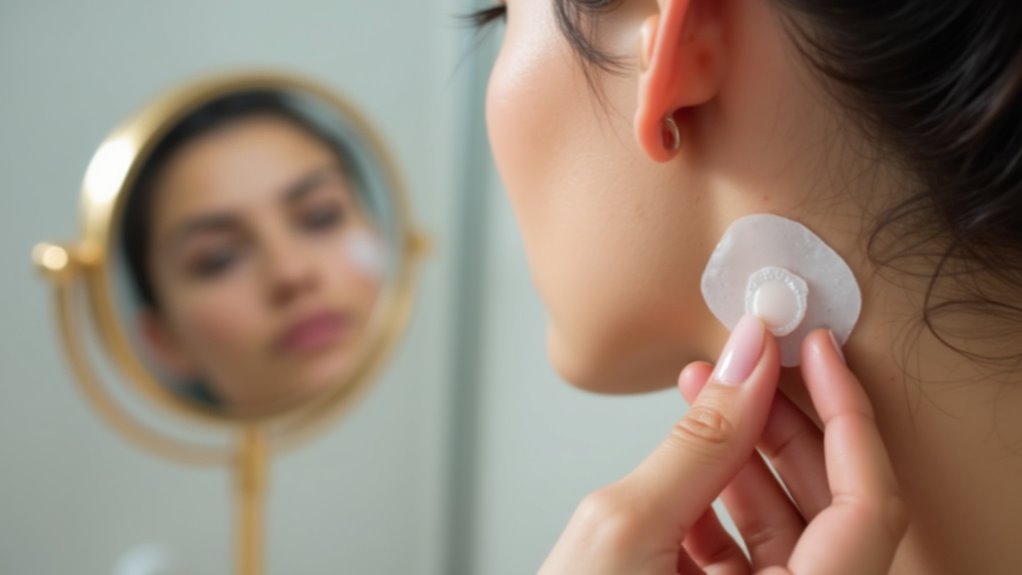
Proper application techniques can make all the difference in the effectiveness of pimple patches. To achieve ideal adhesion, start by applying the patch on clean, dry skin after cleansing and toning.
Avoid using any oil-based skincare products beforehand, as they can hinder the patch’s ability to stick. If you have long nails, use tweezers for application to prevent bacteria transfer.
The hydrocolloid in the patch needs at least six hours to work effectively, so keep it on for at least eight hours, preferably overnight, to maximize its healing potential.
Finally, remember to check the patch’s opacity; removing the patch when it turns opaque ensures you’re getting the full benefits of your treatment.
Recognizing the Limitations of Hydrocolloid Patches
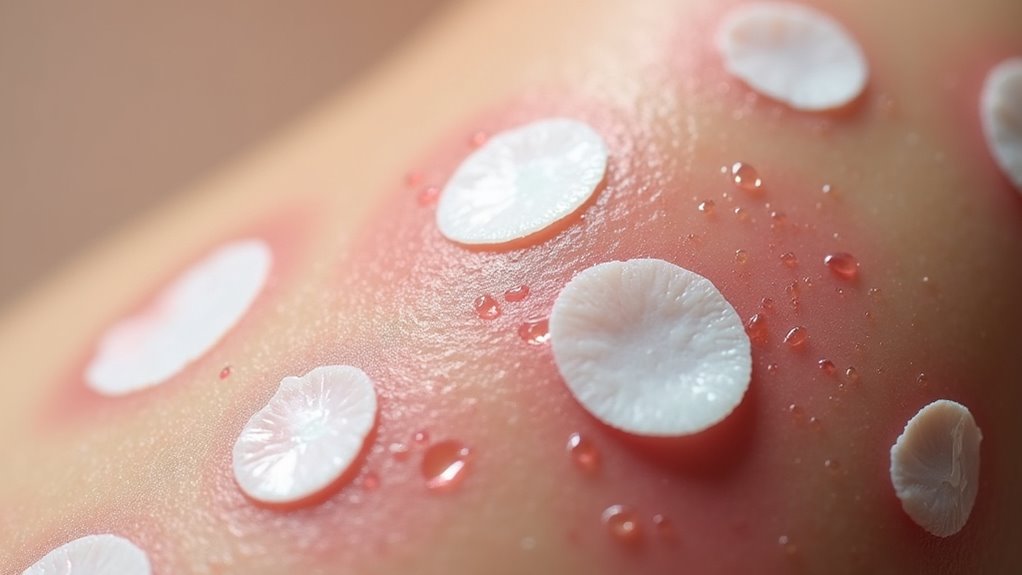
While hydrocolloid patches can work wonders on whiteheads, they fall short with cystic acne and deeper lesions. If you have sensitive skin, you might find that these patches cause irritation or an allergic reaction. It’s vital to recognize these limitations to set realistic expectations for your acne treatment. Additionally, these patches are often recommended for overnight use to maximize their effectiveness on blemishes.
Types of Ineffective Pimples
Hydrocolloid patches can be a game-changer for treating certain types of acne, but they’ve their limitations.
While they’re effective for mild to moderate acne like whiteheads, they fall short with deeper lesions such as cystic acne. These painful bumps require more intensive treatments since hydrocolloid patches can’t penetrate the skin’s surface.
You’ll also find that pimple patches don’t work on blackheads or clogged pores, as they lack the necessary fluid for absorption. Additionally, if you try to use them on inflamed pimples without a visible whitehead, their effectiveness diminishes.
Skin Sensitivity Concerns
Using hydrocolloid patches can be a helpful way to manage certain acne types, but it’s important to evaluate skin sensitivity issues before applying them.
If you have sensitive skin, these patches might cause skin irritation or even allergic reactions. They’re particularly ineffective for acne types like clogged pores and blackheads, which lack the fluid needed for absorption.
Additionally, cystic acne, with its painful lumps beneath the skin, usually needs more intensive treatment than hydrocolloid patches can provide. If you’re prone to skin irritation, be cautious—these patches could exacerbate your sensitivities.
Always check for potential allergies to common ingredients, like adhesives, as they can limit the patches’ effectiveness and lead to adverse reactions.
Alternatives to Pimple Patches for Stubborn Acne

If you’re struggling with stubborn acne that pimple patches just can’t tackle, there are several effective alternatives worth considering.
For persistent cystic acne, try incorporating salicylic acid or benzoyl peroxide spot treatments. These can penetrate deeper into the skin and target the root of your acne issues.
Additionally, chemical exfoliants like BHAs and AHAs help prevent clogged pores by promoting cell turnover and sloughing away dead skin cells.
Chemical exfoliants, such as BHAs and AHAs, effectively prevent clogged pores by enhancing cell turnover and removing dead skin cells.
If your breakouts remain inflamed and unresponsive, professional treatments such as corticosteroid injections or laser therapy may provide immediate relief.
Finally, scheduling regular consultations with a dermatologist can lead to tailored treatment plans that go beyond the limitations of pimple patches, ensuring you find the right approach for your chronic acne. Transparency in sourcing and manufacturing processes can also help you choose effective products that won’t irritate your skin.
Maintaining a Consistent Skincare Routine for Better Results
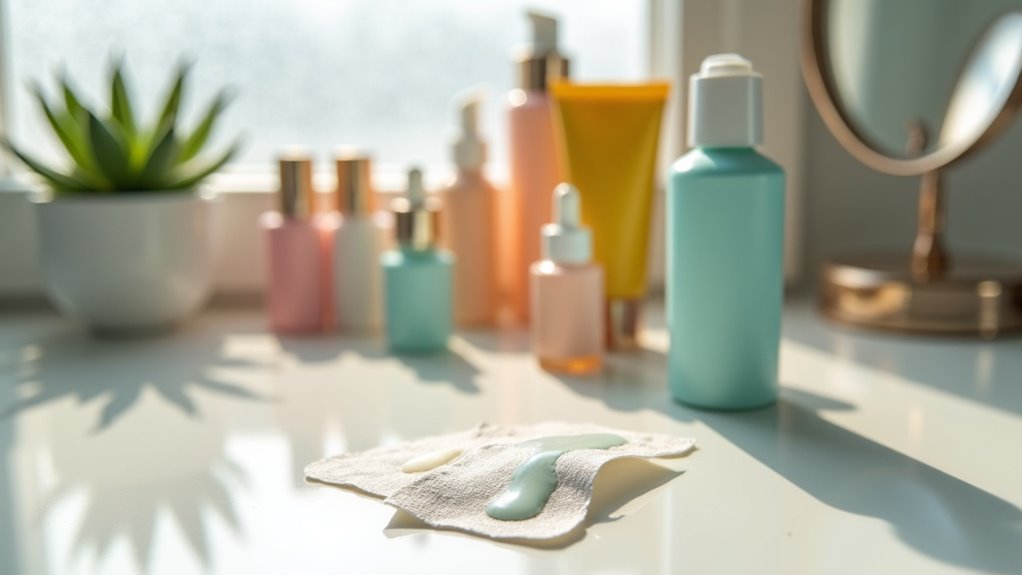
To get the most out of your pimple patches, you need a solid skincare routine.
Start with daily cleansing to keep your skin clear, and add gentle exfoliation a few times a week to prevent clogged pores. Additionally, consider using an air purifier to reduce indoor air quality issues that may exacerbate skin problems.
Daily Cleansing Importance
Daily cleansing plays an essential role in achieving clear skin, as it effectively removes excess sebum, dirt, and makeup. A consistent skincare routine helps maintain balance and reduces acne triggers, maximizing the effectiveness of pimple patches. Using a gentle, oil-free cleanser like Cloud Wash guarantees your skin stays clean and dry, preparing it for treatment. Additionally, hydration is important for maintaining skin elasticity and glow, which can enhance the overall effectiveness of your skincare routine.
| Step | Action | Purpose |
|---|---|---|
| 1 | Use a gentle cleanser | To remove excess oil and dirt |
| 2 | Rinse thoroughly | To guarantee a clean surface |
| 3 | Pat skin dry | To enhance patch adhesion |
| 4 | Apply patches | To absorb impurities and heal |
Prioritize daily cleansing for clearer, healthier skin!
Regular Exfoliation Benefits
Cleansing sets the foundation for clear skin, but regular exfoliation takes your routine a step further. By incorporating exfoliation, you effectively remove dead skin cells that can lead to clogged pores and future breakouts.
Using a gentle BHA toner 2-3 times a week can enhance your skin texture and greatly reduce acne severity. This consistent routine not only helps maintain clean skin but also optimizes the effectiveness of your pimple patches, ensuring proper adhesion and absorption of active ingredients. Additionally, it is important to dilute essential oils properly for safe topical application, especially if incorporating aromatherapy into your routine.
Ultimately, regular exfoliation promotes cell turnover, aiding immediate acne treatment and contributing to long-term skin health and clarity. So, don’t skip this essential step; your skin will thank you for it!
Frequently Asked Questions
Why Do I Have a Patch of Pimples That Won’t Go Away?
If you’ve got a patch of pimples that won’t go away, it might be due to deeper acne types like cystic or nodular acne, which don’t respond well to typical treatments.
Lifestyle factors like stress, diet, and skincare routines can also play a role. Allergies to ingredients in your products might be causing issues too.
Make sure you’re cleansing and prepping your skin properly, as that can affect how well treatments work.
What Is the Max Hours for a Pimple Patch?
So, you think a pimple patch is a magical cure that’ll fix your skin woes overnight? Well, you’re in for a surprise!
The max time for wearing a pimple patch is 24 hours, but ideally, you should stick to 4 to 12 hours for best results.
Keep an eye on it; once it turns opaque, it’s time to say goodbye. Leaving it longer can lead to irritation, and nobody wants that!
Do Pimple Patches Work if the Pimple Isn’t Popped?
Pimple patches can still offer some benefits, even if the pimple isn’t popped. They create a protective barrier that helps reduce inflammation and prevents you from picking at it, which can lower the risk of scarring.
However, they won’t draw out impurities as effectively as they’d on an open blemish. For deeper pimples, it’s a good idea to combine patches with other treatments, like salicylic acid, for better results.
Why Should You Not Put Patches on Pimples?
You wouldn’t want to put a pimple patch on a stubborn mountain of a pimple! They’re designed for surface-level imperfections, so if your pimple is deep or inflamed, you’re wasting your time.
Plus, if there’s excess oil or product on your skin, the patch won’t stick properly. Instead of relying solely on patches, incorporate them into a skincare routine that tackles the root causes of your breakouts for the best results.
Conclusion
To sum up, while pimple patches can be a handy tool for treating certain types of acne, they aren’t a cure-all. For instance, if you’ve got a deep cystic pimple, a patch might not cut it. Instead, consider consulting a dermatologist for stronger treatments. Remember, maintaining a consistent skincare routine is key to preventing future breakouts. So, take care of your skin, and don’t rely solely on patches for those stubborn zits!

